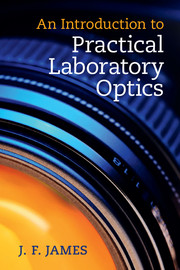Book contents
- Frontmatter
- Contents
- Preface
- 1 Introduction: centred optical systems
- 2 Telescopes and binoculars
- 3 Eyepieces, eyes and colour
- 4 Cameras and camera lenses
- 5 The scientific CCD camera
- 6 Spectrometry
- 7 Interferometers and their uses
- 8 Electro-optical effects and their practical uses
- 9 Microscopes and projectors
- 10 Siderostats and coelostats
- 11 The detection and measurement of radiation
- 12 Practicalities
- Appendix A Gaussian optics
- Appendix B Optical aberrations
- Appendix C A brief introduction to Fourier optics
- Further reading
- Index
10 - Siderostats and coelostats
Published online by Cambridge University Press: 05 October 2014
- Frontmatter
- Contents
- Preface
- 1 Introduction: centred optical systems
- 2 Telescopes and binoculars
- 3 Eyepieces, eyes and colour
- 4 Cameras and camera lenses
- 5 The scientific CCD camera
- 6 Spectrometry
- 7 Interferometers and their uses
- 8 Electro-optical effects and their practical uses
- 9 Microscopes and projectors
- 10 Siderostats and coelostats
- 11 The detection and measurement of radiation
- 12 Practicalities
- Appendix A Gaussian optics
- Appendix B Optical aberrations
- Appendix C A brief introduction to Fourier optics
- Further reading
- Index
Summary
The celestial sphere
For the purposes of observational astronomy and celestial navigation, it is adequate to assume that the Sun, stars and planets all lie on the surface of a transparent sphere of ‘immeasurably’ large diameter with the Earth, or sometimes the observer, at its centre. The positions of the stars on this sphere are given by coordinates similar to those of latitude and longitude on Earth, but known generally as declination (latitude) and celestial longitude, measured westward from ‘the first point of Aries’. This is the place on the sky where the Sun crosses the equator going northwards each (northern) Spring and was once in the constellation of Aries. (Because of the ‘precession of the equinoxes’ it is now in the constellation of Pisces.)
Formerly longitude was measured eastward from the first point of Aries. It was called ‘right ascension’ and was measured in hours and minutes rather than degrees. These hours were sidereal hours not solar hours, with the understanding that Earth rotates through 360° in 24 sidereal hours, or 23 hours 56 minutes of solar mean time. Sidereal clocks gain 4 minutes each day on ordinary clocks since the Earth rotates through approximately 361° from one midday to the next.
Information
- Type
- Chapter
- Information
- An Introduction to Practical Laboratory Optics , pp. 124 - 129Publisher: Cambridge University PressPrint publication year: 2014
